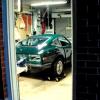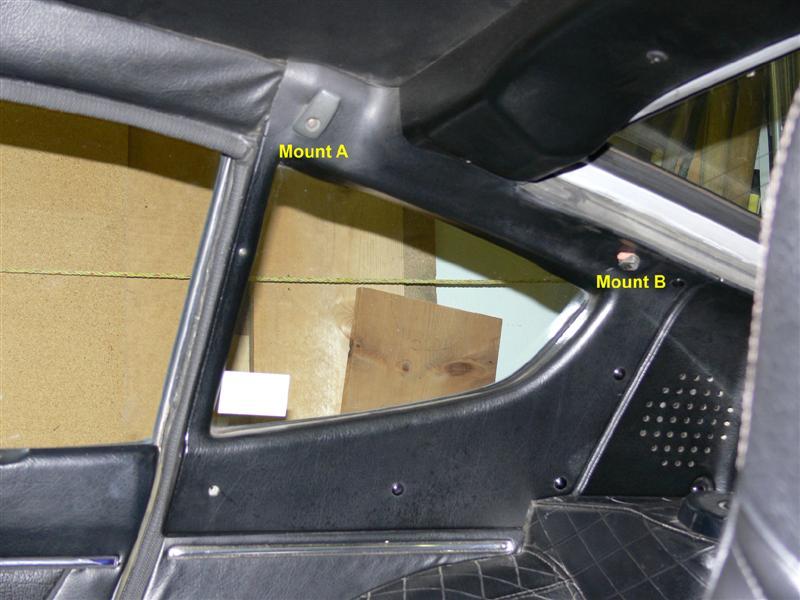Everything posted by Namerow
-
Rear interior vents
Overall, I think it was a brilliant design... for its time. Some of its shortcomings got remedied by Nissan relatively quickly (e.g. the angled halfshafts). Others stayed pretty much untouched (you can make up your own list ). Of course, that's part of the reason why most of us enjoy owning these cars.
-
The definitive Z book
David Halberstram's book, 'The Reckoning' provides a fascinating comparison of the histories of Nissan Corp. vs. Ford Motor Corp., using them as proxies for the Japanese vs. the US auto industries.
-
Rear interior vents
Here are a couple of pix that I have on file that show the placement of the 'vent' holes in the later-design hatch side panels (I'm pretty sure that the panels for the Series 1 design did not have these holes). I don't have a precise measurement (and I'm too lazy to go out to the garage to make one), but the holes appear to be about 2/3 the diameter of the holes used for the plastic rivets... In the 1980's, I worked as a project engineer for a company that designed and built wind tunnels (not model-scale -- the real ones) for the automotive and aerospace industries. We worked with Porsche, Honda, Volvo, Ford, Hyundai and others (even Williams GP Engineering, but that's another story). It was clear that the auto manufacturers at that time were only just beginning to pay proper attention to locating and sizing the cabin extractor vents for effective HVAC performance. The Z was designed in the late 1960's and the extractor vent positioning appears to have been based on educated guesswork rather than wind tunnel testing (although Nissan did own a wind tunnel at the time). Even when working as designed, the Series 1's extractor vent system can be best described as an intriguing but complicated failure. The re-location of the vents in the C-pillars got rid of the exhaust fume problem and the water drainage requirement (along with a lot of parts and assembly steps), but the revised design doesn't provide enough outlet area to be very effective. So I wouldn't be too concerned about venting the plastic interior trim panels because it's not going to make much difference.
-
Tired of taking advice
The Appliance 'mesh' wheel was inspired by the wheels that the Chaparral team developed (apparently in-house) for their Chaparral 2 sports racer circa 1965. According to team owner Jim Hall, they had their wheels manufactured by a local alloy casting operation. The Appliance wheels were pretty popular with Z owners for a while (late 1970's). They haven't aged as well as the 'slotted mag' design, IMO.
-
Dashcam Recommendations?
A step in the right direction, although only after the fact. Working against its impact is the probability that most drivers get behind the wheel with some offsetting assumptions: 1) they have good or superior skills compared to other drivers; 2) accidents only happen to other people, and; 3) accidents are always the fault of the other driver. Exactly how does a police officer decide -- without witnesses who are ready to testify -- that there is enough evidence to warrant pressing charges over illegal cellphone use? I wonder what % of 'distracted driving' cases actually result in convictions? (as opposed to charges being laid but not sticking)? Much of the growing appeal of autonomous and semi-autonomous vehicle technology lies in the promise of 'drivers' being able to text, read emails, and watch videos while sitting behind the wheel. Not that there's anything wrong with that as an outcome (if it works). The problem we have at the moment is that a lot of people aren't prepared to wait until that technology is in place!
-
Vintage Air Gen II mini Install
Very nicely done - both words and pix.
-
Ghosn Arrested in Japan and Fired by Nissan
Peter DeLorenzo's overview in Autoextremist.com makes for interesting reading.
-
Need small amt. of black firewall insulator material
I may be able to help you out. Depends on whether I kept the original from my 70Z after using it as a template to make a new one. I won't be able to check until Sunday. Where are you located in 'Canada'?
-
s30 NOS quarter panels
Looks like a fabulous tool, but not a casual purchase at US$1,500 (plus tax, duty and shipping). Which to buy first: plasma cutter? oxy-acetylene kit? floor lift? induction-heating fastener remover?
-
Ghosn Arrested in Japan and Fired by Nissan
Looks like he may be toast. He is said to have made many enemies and this may be the result. Another dubious milestone for Nissan Motor Corp.
-
Datsun 240Z Shim doors
I think it's not very likely that you'll find these Nissan shim plates. Not impossible. Just unlikely. However. they're nothing more than pieces of stamped metal plate. You can easily make your own. For reference, auto body shim plates are typically provided in four thicknesses: 1/64", 1/32", 1/16" and 1/8" (0.4mm, 0.8mm, 1.2mm and 1.6mm). For the door shim plates, a little adjustment at the the front of the door will make for a lot of angular adjustment at the bottom and top of the door, so I'm thinking that a set of 1/64" and 1/32" plates would be the way to go. The thicknesses don't have to be exactly 1/64" or 1/32". Use what you can find conveniently. These shim plates don't need to be pretty and they don't need to be shaped to +/- 0.001" tolerances.
-
Found old Z pictures. I’ll start!
You, missus and daughter?
-
Interesting wire connector
Looks like a great solution to a longstanding repair/restoration issue. Good to have your 'lab test' results, verifying the mechanical strength and electrical quality of the resulting connection. I'm always a bit unhappy with my Western Union-style connections because they're so bulky. Good mechanics, bad aesthetics. These look much more acceptable than the ubiquitous crimp-on connectors that are typically used to fix cut or broken wiring. And a lot better than solder-and-electrical tape! Hard to believe that underhood temps would ever get to the level of melting the solder here -- unless the connection is sitting near the exhaust manifold.
-
In case you missed it
The Toyota's value is created by two factors: 1) rarity, and; 2) halo effect from being featured, in period, in an early James Bond movie (see also: Aston Martin DB5). Of course, it needs to be an attractive car, too, but -- as demonstrated by the 240Z -- that's not enough. Scarcity + Cachet ('exotic') = $$$$$. As noted above, the car is surprisingly small when seen in person. I read somewhere that the Bond film producers wanted to use a coupe for the film but the lead actor, Sean Connery, couldn't sit in the car without hitting the roof. The car has some lovely lines in side profile, but the styling details used at the front and rear ends are 'unique'.
-
original jute for 240Z wanted
This vendor sells authentic jute... www.the-roadster-factory.com
-
Rust-Prevention Product Comparison Test
i could be wrong, but I don't think that the Eastwood internal frame coating product had been introduced at the time when the magazine started their comparison test.
-
Rust-Prevention Product Comparison Test
This should generate some lively discussion... Most of us have tried a variety of rust-prevention products. If you're like me, you've found that some don't quite live up to expectations. Many swear by a particular product, but I often wonder if their allegiance is tied to subconsciously defending the choice they made. There are lot of manufacturer's claims published and a lot of one-use testimonials, but not much in the way solid comparative date to back them up. Back in 2011, 'Classics Monthly' -- one of England's leading auto restoration publications -- began a test of a group of the leading, over-the-counter rust prevention products. The test lasted for three years. The products were split into two categories: 1) those for pre-paint treatment of exterior surfaces, and; 2) those for treatment of concealed internal surfaces (door cavities, frame rails, rocker sills, etc). The results were quite interesting... https://www.auson.se/sites/default/files/rusttest_noxudol_700_classic_monthly_uk_0.pdf
-
Not a Z but similar 2003 Honda S2000 $12,000 USD
Typical Honda issues, IMO: Superb engineering, accompanied by indifferent exterior and interior styling. The NSX seems to draw the same reaction.
-
1971 HLS30-14938 "Lily" build
Ow. Ow. Ow. That couldn't have been a good moment (looks like something I would do). How well did the rail respond to the slide hammer? Did you have to use any heat to get the metal to shift?
-
It's up for sale again!
This is the other end of S30 reality. For every $40K car helping to set the upper end of the pricing envelope, there's a couple of these that keep the bottom end firmly anchored at $500 (aka, 'Asking $1200'). This car is located about 45 minutes from Grannyknot, so perhaps we'll see it showing up in his driveway soon? p.s. I, too, noticed the 'L0L' postal code. I wonder if the seller will get the joke?
-
7" brake booster repair and restoration
If I understand the loads here, the staking on the collar is used simply to retain the head on the shaft as the shaft retracts. Not much loading on the ends of the pins (or the staked dimples). Interference fit, LocTite, or both. Anyway, my idea was offered as 'a possible alternative', rather than, 'a better solution'. I look forward to seeing the DIY staking machine that you are trying to come up with.
- Photo from the 70's my uncles 240z and a few other cars
-
Where to go with this rusthole
Kudos for three of the best pictures I've seen that show the challenge of repairing the Z dogleg. This seems to be the single most important and consistent repair area for a Z and yet no one manufactures a repair panel kit to address the problem. If these were Alfas or Porsches, someone would be making the kit. Disepsyon is a very talented guy, but he's not interested in making 100+ repair kits. We really need someone like MSA or ZCar Depot to step up here.
-
7" brake booster repair and restoration
Thinking out loud here (always dangerous, I know). Instead of the factory strategy of staking the part, is there enough wall thickness to take three short pins? Dress the ends to make them round-ish. Drill the holes for a close fit (Loc-tite) or a light interference fit. The pins wouldn't be subjected to much in the way of long-axis loading. Just 'wobble' loading.
-
7" brake booster repair and restoration
@katsToo bad, but at least we now know with certainty. Thanks for investigating. We will now need to hope for a successful outcome from Patcon's experiment with the Mustang kit.








